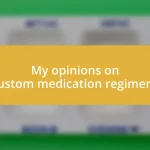Key takeaways:
- Utilizing diverse perspectives, data analysis, and scenario planning enhances the effectiveness of risk assessment techniques.
- Effective risk identification relies on collaboration, monitoring industry trends, and leveraging technology for real-time insights.
- Continuous reassessment and clear communication are vital in adapting risk management strategies and fostering team engagement.

Understanding risk assessment techniques
One of the first techniques I often encounter in risk assessment is the qualitative approach. I remember a time when I had to evaluate a project’s risks based primarily on team input. Gathering insights from diverse perspectives not only made me appreciate the value of collaborative judgment but also highlighted how personal experiences can shape our understanding of potential pitfalls.
Another technique that stands out for me is quantitative risk assessment, which relies on numerical data to predict risks. I still think back to a project where we used statistical analysis to evaluate historical data. It was eye-opening! The numbers helped us identify trends that we’d never noticed before, making our decision-making process much clearer. Doesn’t it feel powerful when data tells a story and guides us?
Lastly, I often find myself reflecting on the importance of scenario analysis. Crafting “what-if” scenarios has allowed me to probe into the future and visualize potential outcomes more vividly. I recall discussing various scenarios with my team, which sparked some of the most engaging conversations. Have you ever considered how much insight a simple discussion about potential futures can provide? It’s moments like these that truly highlight the value of diverse thinking in risk assessment.

Identifying potential risks effectively
Identifying potential risks effectively requires a keen eye for detail and an openness to various perspectives. I remember a time when a simple brainstorming session revealed risks we hadn’t considered. By openly encouraging every team member to voice their thoughts, we stumbled upon a critical project risk hidden in plain sight—one that could have easily derailed our efforts. In my experience, the more diverse the team, the richer the pool of insights for identifying potential risks.
Another aspect I find crucial is keeping an eye on industry trends and news. I once encountered a significant risk in a project by closely following relevant market shifts and regulatory changes. Staying informed turned out to be a game-changer, as it allowed my team to proactively adjust our strategies ahead of time. Have you ever thought how external factors can influence your project’s success or failure? I often remind myself that the environment in which we operate is just as important as the project details.
Lastly, leveraging technology to assess risks can be particularly effective. I’ve utilized various software tools that helped us track potential risks in real time. I still recall how one tool allowed us to create a risk register that visualized risks and their potential impacts. It was like having a compass guiding us through uncharted waters, helping us navigate with confidence. Utilizing technology not only streamlines the process but also enhances our ability to identify and react to risks promptly.
| Technique | Example |
|---|---|
| Collaborative brainstorming | Engaging team insights to uncover hidden risks |
| Monitoring industry trends | Adjusting strategies based on market shifts |
| Leveraging technology | Using risk registers for real-time tracking |

Evaluating risk likelihood and impact
Evaluating the likelihood and impact of risks is an essential step in my risk assessment process. I still remember a pivotal moment when I had to weigh the potential impact of a high-profile stakeholder’s departure on my project. The anxiety in the room was palpable as we forecasted how this change could ripple through our plan. It was a clear reminder of how essential it is to not only calculate the probability of a risk occurring but also to fully grasp how profoundly it might affect our objectives.
In my experience, I’ve found a structured approach helps clarify this evaluation. Here’s a simple framework I often use to determine risk likelihood and impact:
- Likelihood: Assess the probability of a risk occurring (e.g., high, medium, low).
- Impact: Evaluate the potential consequences if the risk were to materialize (e.g., critical, serious, minor).
- Prioritization: Combine the two evaluations to prioritize risks effectively (e.g., a high likelihood and critical impact should be addressed first).
Mapping risks in this way transforms the abstract concept of risk into a tangible action plan. Engaging my team in this process often leads to rich discussions, uncovering nuances I hadn’t considered before. The interconnectedness of their insights and my experiences makes the risk evaluation process feel less daunting and far more collaborative.

Prioritizing risks based on severity
When prioritizing risks based on severity, I find that visualizing the potential impacts can be incredibly clarifying. I once managed a project where a looming compliance deadline was rated as medium risk, but as we delved deeper, it became clear that non-compliance could lead to hefty fines. That moment of realization brought the severity of potential repercussions into sharp focus for the entire team. Have you ever noticed how a single piece of information can shift your entire perspective on risk? It’s such an eye-opener.
I also recommend categorizing risks into tiers of severity—this method has consistently worked for me. By defining what constitutes high, medium, and low severity, my team can react appropriately. For instance, in a previous project, a technical error was considered low severity but quickly escalated when we noted it could delay our launch by weeks. The urgency of response changes dramatically when you layer in severity, doesn’t it? It’s about transforming that initial assessment into action steps that match the potential fallout.
Emotional engagement plays a significant role in our discussions around severity. I recall a particularly tense meeting where we discussed risks related to a key partner’s potential exit. The weight of the situation was palpable; it urged us to prioritize that risk above others with lower severity. Witnessing my team’s concerns—some visibly distressed—made it clear how essential it was to validate those feelings in our risk assessment process. It’s fascinating how emotions can guide our decisions, isn’t it? Understanding the emotional stakes often leads to a more holistic evaluation of risks, underscoring the importance of prioritizing based on severity.

Developing risk mitigation strategies
Developing effective risk mitigation strategies requires a thoughtful blend of foresight and flexibility. I vividly remember a project where we faced potential supply chain disruptions. Instead of merely bracing for impact, I organized a brainstorming session with my team to explore alternative suppliers. It was inspiring to witness the creativity that emerged from this dialogue. Have you ever noticed how collaboration can spark innovative solutions to challenges?
One strategy I frequently employ is creating a detailed response plan for high-priority risks. For instance, when we identified a critical software dependency in an ongoing project, we mapped out our approach to both mitigate and respond to potential failures. That plan became our safety net, providing direction and peace of mind. I can still recall the relief we felt when we could confidently discuss what measures we would take, should the unforeseen arise. It’s remarkable how having a clear plan can alleviate the anxiety surrounding risk, isn’t it?
Continuous reassessment is also crucial in my approach to risk mitigation. During a major product launch, we frequently revisited our risk strategies, adapting them based on real-time feedback and developments. I remember a moment when a last-minute market shift prompted us to pivot our messaging. It was exhilarating to see how quick adjustments could turn potential setbacks into opportunities. This experience taught me that staying adaptable and receptive can truly empower a team to navigate uncertainty. How do you stay flexible in your risk mitigation plans?

Implementing and monitoring risk plans
Implementing a risk plan is more than just paperwork; it’s about embedding a proactive mindset within the team. I recall when we first rolled out our risk management framework; the initial skepticism was palpable. To combat this, I arranged regular check-ins to review our progress and share updates, which gradually shifted the team’s perception. It’s fascinating to see how consistent communication can help in cultivating a culture of vigilance, isn’t it?
Monitoring the effectiveness of our risk plans involves a blend of quantitative metrics and qualitative feedback. For example, I once used a simple dashboard to track risk incidents and resolutions. Each time a potential risk was neutralized, we celebrated the win as a team, reinforcing our shared commitment to proactive risk management. It’s funny how acknowledging these small victories keeps morale high and encourages everyone to stay alert and engaged with the process.
I also emphasize the importance of learning from our experiences during the monitoring phase. I remember a challenging moment when a risk we thought was under control re-emerged unexpectedly. Instead of casting blame, we conducted a thorough post-mortem to identify what went wrong. This transparency not only fostered trust but inspired us to fine-tune our monitoring practices. Have you ever found that digging into past missteps can illuminate lessons that help you grow stronger as a team? It’s all about transforming potential pitfalls into guiding insights.

Reviewing and adjusting risk assessments
Reviewing risk assessments is something I take to heart, often reflecting on past experiences to gauge their effectiveness. I remember a software development project where we made it a routine to revisit our risk assessments during weekly team meetings. This simple practice not only kept everyone on the same page but also fostered a sense of ownership among team members. Isn’t it amazing how regular reflection can turn abstract ideas into actionable insights?
When it comes to adjusting risk assessments, I’ve found that flexibility is key. I had a project where we initially underestimated the impact of regulatory changes. As soon as we recognized the oversight, we promptly gathered the team and re-evaluated our approach, adjusting our risk scores and mitigation strategies accordingly. This pivot not only minimized potential disruptions but also brought the team closer together, reinforcing the importance of adaptability. Have you experienced that moment when a sudden change forces a team to rally together?
Finally, it’s crucial to communicate these adjustments clearly. After revising our risk assessments, I make it a point to share the new strategies with stakeholders, ensuring that everyone understands the rationale behind the changes. In one instance, I presented our findings in an engaging storytelling format, illustrating the progression of our thought process. The feedback was overwhelmingly positive, as it turned a potentially dry subject into a compelling narrative. How do you convey complex adjustments to your team in a way that promotes understanding and engagement?














